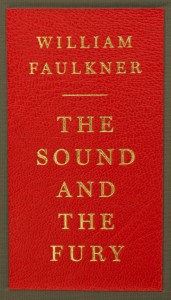
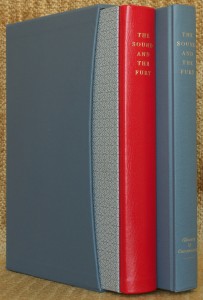 The Sound and the Fury is one of those landmark books that are the result of herculean human effort from everyone involved. The importance of the book manifests in several ways. It was influential in why Faulkner won the Nobel Prize for Literature in 1949, with the academy citing his ‘powerful and artistically unique contribution to the modern American Novel’. The Modern Library list of the 100 best English-language novels of the 20th century has it ranked 6th by the board and 33rd by the readers. Challenging novels like this excite me despite their difficulties for the reader. When the Folio Society took on the challenge of printing a unique limited edition, I couldn’t wait to get my hands on it.
The Sound and the Fury is one of those landmark books that are the result of herculean human effort from everyone involved. The importance of the book manifests in several ways. It was influential in why Faulkner won the Nobel Prize for Literature in 1949, with the academy citing his ‘powerful and artistically unique contribution to the modern American Novel’. The Modern Library list of the 100 best English-language novels of the 20th century has it ranked 6th by the board and 33rd by the readers. Challenging novels like this excite me despite their difficulties for the reader. When the Folio Society took on the challenge of printing a unique limited edition, I couldn’t wait to get my hands on it.
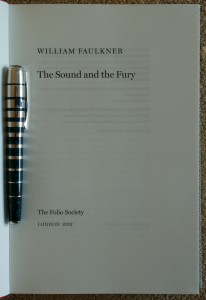
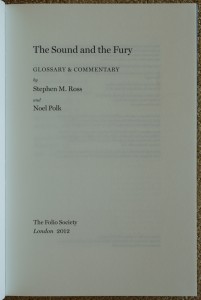 So what makes this book so of an effort and so challenging for everyone?
So what makes this book so of an effort and so challenging for everyone?
For the writer, the stream of consciousness techniques from three different perspectives and accompanying abrupt and random time-shifts must have been tough to keep straight while Faulkner wrote it. The author was a pioneer of this technique, along with James Joyce and Virginia Wolfe. When he handed the manuscript over to his agent in 1929, he told him “It’s a real son-of-a-bitch…this one’s the greatest I’ll ever write.”
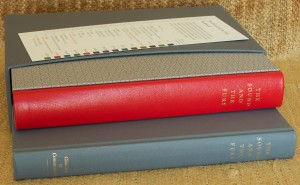 The publisher was then challenged to take Faulkner’s manuscript and create a book that captured the writer’s intent. This was no easy task. Faulkner’s agent, Ben Wassom, took the first misstep in “correcting” the author’s use of italics to mark time shifts in order to make ‘the sheer technical outrageousness and freshness of the Benjy section’ easier to read and understand. This
The publisher was then challenged to take Faulkner’s manuscript and create a book that captured the writer’s intent. This was no easy task. Faulkner’s agent, Ben Wassom, took the first misstep in “correcting” the author’s use of italics to mark time shifts in order to make ‘the sheer technical outrageousness and freshness of the Benjy section’ easier to read and understand. This 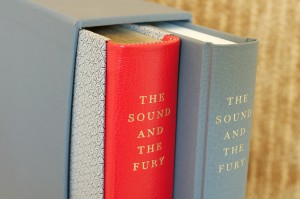 prompted an angry letter from Faulkner with just a quick count of the time shifts and a desire to find a printer willing to match the innovation of the novel with similar innovation in printing. His idea was to print it in multiple colors representing the shifts in time perspectives. There were plans for the Grabhorn Press to realize his dream but the Great Depression put an end to the project and the only copy with Faulkner’s own notes for colorization disappeared. What a gem that might have been!
prompted an angry letter from Faulkner with just a quick count of the time shifts and a desire to find a printer willing to match the innovation of the novel with similar innovation in printing. His idea was to print it in multiple colors representing the shifts in time perspectives. There were plans for the Grabhorn Press to realize his dream but the Great Depression put an end to the project and the only copy with Faulkner’s own notes for colorization disappeared. What a gem that might have been!
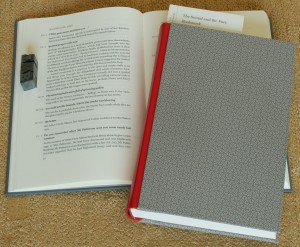 So readers got a book printed the standard way in black ink. Even if your edition had Faulkner’s italics or other devices, his lack of standard punctuation and other stream of consciousness techniques made for challenging and rough going. Stream of consciousness can be hard enough to read when applied to any character but Faulkner may have been the first to apply it to an individual with a cognitive disability. Is this really how Maury/Benji perceived the world? Possibly. It is certainly different from the neurotic Quentin’s section with its equally loose shifts back and forth in time. Jason’s section becomes easier and more linear
So readers got a book printed the standard way in black ink. Even if your edition had Faulkner’s italics or other devices, his lack of standard punctuation and other stream of consciousness techniques made for challenging and rough going. Stream of consciousness can be hard enough to read when applied to any character but Faulkner may have been the first to apply it to an individual with a cognitive disability. Is this really how Maury/Benji perceived the world? Possibly. It is certainly different from the neurotic Quentin’s section with its equally loose shifts back and forth in time. Jason’s section becomes easier and more linear 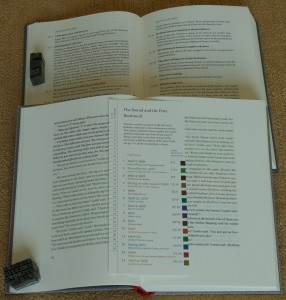 but that doesn’t make him very likeable. In fact, I found him the most unsavory of Bascomb/Comptons. The novel then closes with a denouement that is the only section without a first person narrator. All this makes for great writing but is enough to overwhelm many readers.
but that doesn’t make him very likeable. In fact, I found him the most unsavory of Bascomb/Comptons. The novel then closes with a denouement that is the only section without a first person narrator. All this makes for great writing but is enough to overwhelm many readers.
Over 80 years after the colorization scheme was scrapped by the depression and technology, the Folio Society steps in with thier limited edition. They used 14 different colors of ink in addition to the italic/roman shifts Faulkner employed in his first draft to help readers with Benjy’s section. To further help the reader, the second commentary volume provides further insight into the text. A handy bookmark with line and color delineations is provided to quickly reference lines between the main and commentary volume as well as keep the colorized time-shift dates straight.
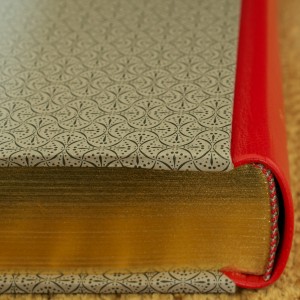 The binding for The Sound and the Fury is like nothing I recall seeing before. It was designed by the talented Russell Maret. He used letterpress printed-paper sides designed exclusively for this edition. He then split the boards so that the quarter leather disappears into the boards while the beautiful paper wraps around the boards on all four sides. The leather is a gorgeous shade of red and is used also for the spine label on the slipcase. Kudos for printing the title on the slipcase spine so the books can be stored with the book spines inward! Interestingly, this may be one of the very few
The binding for The Sound and the Fury is like nothing I recall seeing before. It was designed by the talented Russell Maret. He used letterpress printed-paper sides designed exclusively for this edition. He then split the boards so that the quarter leather disappears into the boards while the beautiful paper wraps around the boards on all four sides. The leather is a gorgeous shade of red and is used also for the spine label on the slipcase. Kudos for printing the title on the slipcase spine so the books can be stored with the book spines inward! Interestingly, this may be one of the very few 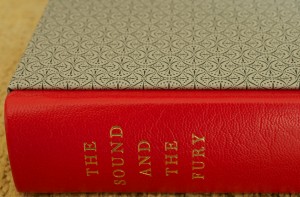 non-illustrated limited editions published by the Folio Society, at least recently. As far as I can tell, their King James Bible is the only other one. The Letterpress Shakespeare main volumes are not illustrated but their commentary volumes are, so I’m considering that as a whole. I was unable to tell if any edition of The Sound and the Fury has been illustrated?
non-illustrated limited editions published by the Folio Society, at least recently. As far as I can tell, their King James Bible is the only other one. The Letterpress Shakespeare main volumes are not illustrated but their commentary volumes are, so I’m considering that as a whole. I was unable to tell if any edition of The Sound and the Fury has been illustrated?
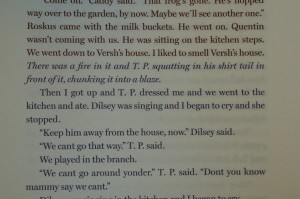 How did all this critical analysis, printing prowess, and beautiful design affect the reading experience and the understanding of the novel? It was definitely a pleasure to see that binding every time I slipped it out of the slipcase. While the paper is not the tactile experience of the mould-made papers used in some limited editions, it is a nice Abbey Wove paper that shows off the type wonderfully. Since this was my second reading of the novel, I chose to approach it by reading several pages and then going through the corresponding commentary to pick up the nuances and additional information provided there. I like to do my first read of a book without the distractions of commentary, footnotes, and the like. The accompanying
How did all this critical analysis, printing prowess, and beautiful design affect the reading experience and the understanding of the novel? It was definitely a pleasure to see that binding every time I slipped it out of the slipcase. While the paper is not the tactile experience of the mould-made papers used in some limited editions, it is a nice Abbey Wove paper that shows off the type wonderfully. Since this was my second reading of the novel, I chose to approach it by reading several pages and then going through the corresponding commentary to pick up the nuances and additional information provided there. I like to do my first read of a book without the distractions of commentary, footnotes, and the like. The accompanying 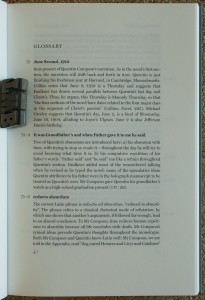 bookmark made it easier to keep track of the colored time shifts and to quickly find line numbers. My next reading will again be straight through without interruptions for the commentary. And I will be reading this novel again, as well as other in his oeuvre, as reading The Sound and the Fury reminded me of the forcefulness of Faulkner’s writing.
bookmark made it easier to keep track of the colored time shifts and to quickly find line numbers. My next reading will again be straight through without interruptions for the commentary. And I will be reading this novel again, as well as other in his oeuvre, as reading The Sound and the Fury reminded me of the forcefulness of Faulkner’s writing.
Faulkner really nails the dark side of that “Southern Thang”. As a born southerner who lived off and on in the Deep South as a kid, I can relate to some of his portrayals of southern characters and characteristics as well as some of the circumstances of the time frame in which the novel is set. His characters in this one are mostly unlikeable, with the exception of Dilsey and the innocent Benjy, so I don’t think I would have wanted to hang around the Compson place. I do admire Faulkner for his attempt to portray the experiences and thoughts of a cognitively disabled character. Part of the power of Faulkner is that he never shies away from the good, the bad, or the ugly in his story. As a writer, he felt he should strive to illuminate ‘the old verities and truths of the heart, the old universal truths lacking which any story is ephemeral and doomed – love and honor and pity and pride and compassion and sacrifice.’
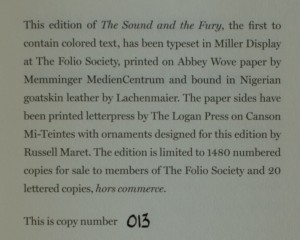 AVAILABILITY: This edition was published in 2012 and was limited to 1480 copies. It sold out shortly after being published. The edition may be available occasionally on the secondary market.
AVAILABILITY: This edition was published in 2012 and was limited to 1480 copies. It sold out shortly after being published. The edition may be available occasionally on the secondary market.

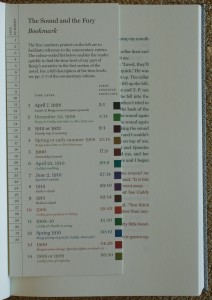
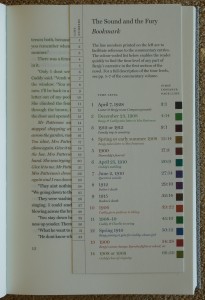
Hello! My name is Álvaro García, from Spain.
A group of friends and I have embarked on the ambitious project of editing the Spanish translation of “The Sound and the Fury”, specifically, colorizing the chapter referring to Benjy. There is no previous work in Spanish with these characteristics. I am seeking (desperate) help from anyone who has a copy of the Folio Society in their hands for share some info. Would you mind giving me a hand? I link my gmail so we can communicate. Please, talk to me!
Sure! And there are probably other readers (more fluent in Spanish than myself!) of this blog and the Folio Society Devotees and Fine Press Forum on LibraryThing that would help you. You might want to reach out there as well.